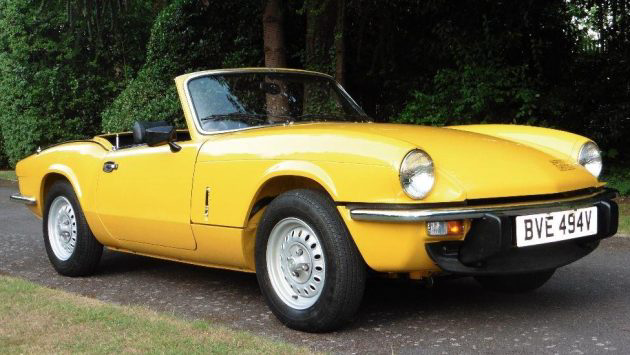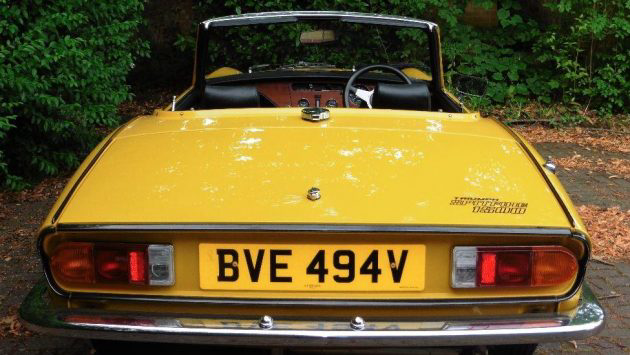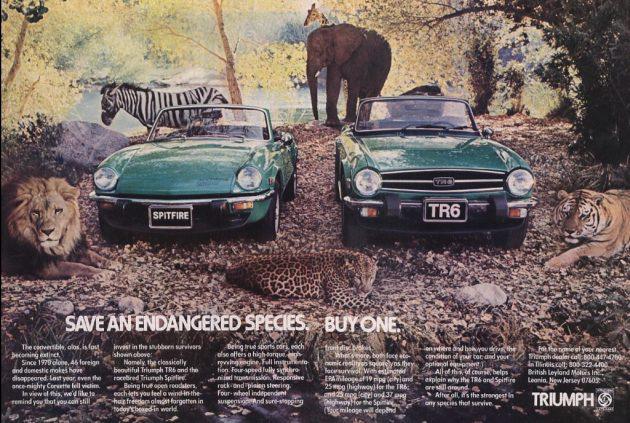3,032 Miles From New: 1980 Triumph Spitfire
I recently came across perhaps one of the best Triumph Spitfires left in existence when flipping through the March edition of Thoroughbred and Classic Cars magazine (guilty pleasure – great content if you’re a reader). They have a monthly section that amounts to test-driving advertised vehicles, and this Spitfire has just 3,032 miles from new! As you’d expect, condition is excellent. Find it here on AutoClassics.com for £22,995, or about $33,000.
This Spitfire wears an excellent color combo of Inca Yellow over Houndstooth, and there’s reportedly never been any paintwork done. In fact, the only change from stock is a replacement stainless steel exhaust – that’s it. Interestingly, there’s no soft top as the Spitfire was optioned with a hard top from the factory. I’m not sure why they wouldn’t supply the car with the soft top in the event you wanted to drive with the top down and tempt the rain gods, but perhaps a Triumph expert (Jamie) can fill us in.
Look at this interior. Stunning. The wood veneer in the dash is uncracked and the three-spoke steering wheel shows no signs of wear. The magazine reported some light bagginess to the driver’s seat, but I see no evidence of it here. When you see an old-school British interior in mint condition like this, it reminds you of how they really knew how to make a driver-focused cockpit. E-Types, MGB GTs, Spitfires – they are luxurious and sporting at the same time, but can look quite tired when not kept up. This Spitfire does not suffer from any signs of heavy use.
If I had the choice between a Spitfire and the TR6, I’d choose the latter – but this Inca Yellow Spitfire is giving me pause. The seller notes: “Having been carefully stored and maintained for the last 37 years, it is unrestored and is in as new condition. The spare wheel has never been fitted and the original toolkit has never been opened.” While over $30K is a ton of money for a Spitfire, they are only original once – and this is likely the best one left.
Auctions Ending Soon
 2002 Subaru Impreza WRXBid Now2 days$333
2002 Subaru Impreza WRXBid Now2 days$333
 1975 Chevrolet Corvette ConvertibleBid Now2 days$4,000
1975 Chevrolet Corvette ConvertibleBid Now2 days$4,000
 1964 Ford F-100 Camper CustomBid Now2 days$2,000
1964 Ford F-100 Camper CustomBid Now2 days$2,000
 2006 Jeep Wrangler SportBid Now4 days$10,500
2006 Jeep Wrangler SportBid Now4 days$10,500
 1974 Datsun 260ZBid Now6 days$750
1974 Datsun 260ZBid Now6 days$750





Comments
Nice car but, I don’t think any spitfire can bring 33K. I don’t think the market is out there.
In the 80’s I always wanted to drive one of these and never got to, now I’m old and would love to own one but not at that price.
I see these from time to time in CL, most having less than 20,000 miles. If you keep your eyes peeled (midwest…mid to late spring especially) you can find a decent driver for around $3000 US.
Wonder what the price a brand new Spitfire would be in 2018 dollars? Around $33k? This is about as close to a fresh out the door Triumph as one might ever find, so perhaps the price is quite reasonable.
List price about 7.5K adjusted for inflation so maybe 22K.
Sweet baby Jeebus, that seems a tad on the expensive side for an 80 spitfire, and the steering wheel is on the wrong dang side! *sarcasm*
Nice once, but it will go downhill from there. I’m on the other end, with a scrap car that I’m building back up, ready for paint. Frame up restorations are easier when you don’t have to decide what to keep or replace- replace it all!
Proud owner of 79 Spit. New engine (9 to 1, cam, big valve head, weber and header) trans, diff, interior, wiring, complete suspension. black over black with minilite wheels.
Nothing like a 90 horsepower freeway legal British gocart!
Hallelujah, it’s got O/D!! ( switch on shift knob) Jubilation quickly turns to disappointment,,,RHD.( unless the picture is reversed,,,nope, RHD) Just goes against all I hold dear. Oh well, I guess we’ll see 10 more Spits without O/D now. This was the one in ten.
I feel ya, Rube. I never did understand why so many Spitfires (and TR6’s) weren’t fitted with overdrive – especially in the US market. When highway speeds were 70 mph, you couldn’t beat O/D for cutting down on the noise and engine wear factor (we weren’t worried about gas mileage then).
I think it was because people didn’t know what it was. If they would have called it a 5 speed it would have sold more. Even though, O/D was nothing new to older Americans younger people,who these catered to, never drove a Nash or Studebaker with O/D. I’m sure buyers regretted not having it the 1st time they hit the highway. While this is pretty obvious, the MGB had the O/D switch on the wiper stalk, and I’d bet some never knew it had it.
MSG Bob;
I worked in the MG/TR business starting in the late 1970s & onward. The primary reason so few Triumph [& MG] cars were equipped with the Laycock De Normanville overdrive was cost. This OD unit was expensive to manufacture, and was almost like a second gearbox, allowing OD in each of the 4 speeds, giving the driver up to 8 forward speeds. In the early 1960s they were fairly expensive when compared with the total cost of a cheaper sports car like the Spitfire. A $185 upgrade to OD on a $2,000 car was a difficult sell to new car buyers.
British car dealers were hesitant to place orders for OD equipped cars due to the cost increase. One of the primary reasons British sports cars sold well in America was their cheap price. Adding an expensive OD started pushing the pricing up towards the lower end of European sports cars.
You could of course, order a new car from Britain, and get overdrive, but it took at least 3 months lead time. Triumph dealers in America often maintained an upgrade OD “Kit” in their parts department that could be retrofitted to a new car if required. Few buyers opted for this dealer kit. The non-OD gearboxes were stuck in the back of the parts department, to be swapped for worn out gearboxes as an exchange. MG B cars generally didn’t get this dealer added OD because of the expense to pull the engine & gearbox, unlike the Triumph where it was a simple gearbox exchange.
In addition, The Laycock De Normanville [in the early days before the bugs were worked out] was trouble prone in America due to hard use under more extreme ambient temperatures and higher mileage. One of the problems was the Laycock used a separate oil supply for the OD. Many small town American repair & service facilities didn’t know the OD oil was supposed to be changed at least every year, sometimes twice a year. American service people thought that when draining the gearbox oil, they thought it drained everything, and the OD never got a fluid change, eventually failing from lack of lubrication.
Few people realize the Laycock OD has a high pressure [400 to 500 PSI!] oil pump and lubrication system. Couple that with a lack of oil changes, and you WILL have a high failure rate. And of course with a high pressure oil pump like that, you can be assured the OD unit didn’t use gear oil like the gearbox, it used engine oil, typically 20W50 today, or 30W back in the ’60s. [Volvo OD requires ATF.] Filling a Laycock with 80W90 gear oil will lead to rapid overdrive failure!
Plus, the electrical solenoid to engage the OD planetary gearset was [gasp!] made by Lucas, and regular solenoid failures helped maintain the Lucas company’s reputation of providing substandard electrical products. When Volvo began using the Laycock OD unit, I’ve been told they switched to Bosch solenoids, making the OD a fairly trouble free unit as long as the oil was changed as required.
While the cost was a bit much(almost $900 dollars today) the lower RPM’s reduced the motor miles, significantly adding to the motors life ( and the driver’s sanity) almost paying for itself. If I’m not mistaken, all automatics are high pressure units ( the O/D is kind of an automatic) and of all the O/D’s I’ve had, MGB, A-H 100-6, Triumph, Volvo, I never had a bit of trouble, and NEVER changed the oil on any of them.( which I’m not particularly proud of, we just never though of it) I believe, my MG had a cutout switch on the shift lever on top of the box, and only allowed O/D in 3rd and 4th, making it a 6 speed( but the difference in 3rd over to 4th direct wasn’t worth it) I always thought the LdN O/D was the toughest part.
And for the record, Lucas wasn’t any worse than any other electrical system.
Too expensive. Two blocks away from me some one owns a MG Midget.
And I’d rather have that one.
Grossly overpriced sad to say. Looks like he has been romancing the almost now legal funny stuff in Canada.
The price is fair but if I drive this car value will go down very fast.
The price is not the problem … adding miles is.
Rube: I tend to agree with you that Lucas products are fairly reliable, except for one very huge design flaw: Prior to WW2, many Lucas vehicle lighting connectors were designed to allow a bare [unsoldered] wire to be inserted into a spring clip connector, by simply pressing down on the spring clip, and inserting the bare wire end.
This was fine if the vehicle was in a dry desert climate, but in a moist climate [like it’s home country], the connections, not held together tightly with soldered terminal ends & screwed or bolted connections, corroded to the point that with low 12 volt current, the slightest corrosion meant a very poor connection.
Subsequent new Lucas lighting products in the post war era usually had screw-down terminals that kept the connections tight. But popular products like the Lucas Voltage Regulators in the 1950s, while equipped with screw terminals, still left the terminals exposed to the elements, and Lucas wiring harness ends still had unsoldered wire that encouraged corrosion in the wire bundle under the screw. This problem is why ALL quality modern wiring harnesses for old cars use dipped solder connections.